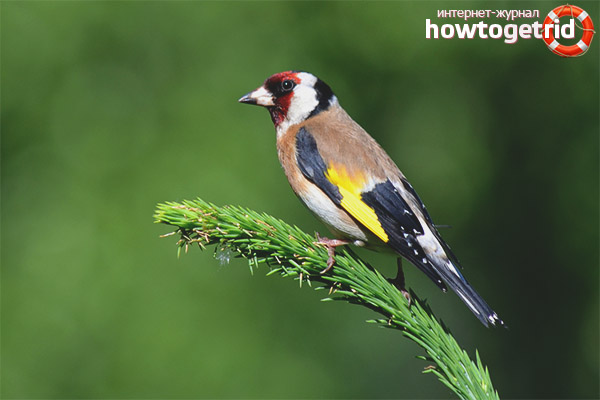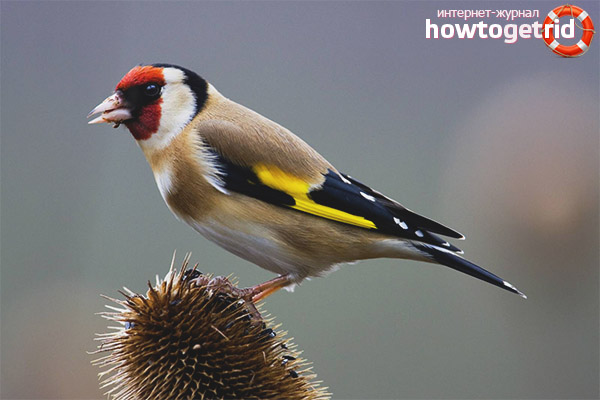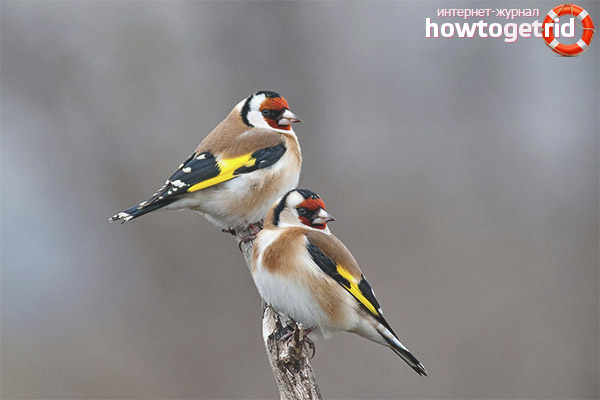The content of the article
Goldfinch is a very bright and beautiful small bird. They sing very beautifully and melodically. It is thanks to these amazing qualities that people often keep this bird at home to enjoy beautiful singing.
The bird is mobile and sociable, quickly attached to people. They belong to the family finch. In Latin, the name of the species sounds like Carduelis carduelis. The name of the species Carduelis appeared because the bird has a very bright, dandy color. And the Latin name of the species came from the word carduus, which in Latin means "thistle". The seeds of this particular plant are a favorite treat of the bird.
Description
There are many other birds belonging to the same family that look like carduelis. For example, greenfinch or tap dance. How to distinguish representatives of this species from other members of the family?
The size of the bird is very small. It has about the same dimensions as a sparrow. An adult individual usually weighs only 20 g. The body of the carduelis is up to 12 cm long, and the wingspan of these small birds is 21-25 cm. Their physique is downed and their head is round. Carduelis neck is short. The beak is small, pointed.
The main difference between this type of bird from the rest is that several bright colors are present in their color. On different parts of the body they have red, yellow, as well as contrasting white and black feathers. The mature carduelis has two jewelry. Its beak is bordered with bright red, and there is a black cap on its head. In males of this species, the red rim located around the beak is somewhat wider. It is this feature that allows you to determine the gender of the bird, according to other indicators they will not differ. On the abdomen they have red plumage, on the back - brownish. Cheeks are decorated with white plumage. The wings, as well as the tail, have a rich black color. On them are yellow spots, as well as white stripes.
Power Features
Chicks eat small insects. Adults also sometimes eat such food.
Living in nature
These birds live in many European and Asian countries, as well as in North Africa. You can meet them in the Caucasus and Siberia. But these birds do not like to migrate. They do this only in case of emergency, if the winter is too cold. They like to live in a settled and well-known area.
If in winter there is severe frost, the inhabitants of the northern latitudes can fly south to wait out the cold.
Wherever these birds live, they prefer to live and nest in gardens, parks or in deciduous forests. Here they choose the edge, because they love a large amount of light. Carduelis choose their nesting places so that nearby they can find food for themselves. Nearby should grow many different herbs from which the goldfinch usually collects seeds.
Views
There are many subspecies of Carduelis. The most numerous species are black-headed as well as gray-headed. In nature, there are also thick-billed and Yemeni. Consider a few basic types.
Blackhead
This species is the most common among all. Birds live in Europe, in western Asia, as well as in the northern part of the African continent.Since there are more representatives of this species in nature, it is called ordinary. It is with this type that everyone else is compared, considering it standard. Their body is downed, small. On the head of the birds there is a characteristic black cap. The plumage in the cheeks is white. Around the beak there is a characteristic red rim. On the wings of the black-headed carduelis, the feathers are painted black and yellow.
Gray-headed
Birds of this species live in Siberia and Asia. Outwardly, it differs from the black-headed carduelis in that it has a larger body. The color of these birds is not so bright.
The plumage is more gray and brown. There are no absolutely white and absolutely red shades in the colors. But the main characteristic feature is the red bezel, which is located around the bird's beak, is present.
Gender differences
Externally, representatives of different sexes are almost the same. But some differences between them can still be noticed. The plumage of the female is somewhat paler and lighter. But she sings more melodically and beautifully. Therefore, it is recommended that those who love female Carduelis are recommended for those who like to listen to birdsong. Another distinguishing feature is a narrower red frame around the beak compared to males. In males, it is wider and reaches almost the eyes of a bird.
More differences are observed between individuals that live in different latitudes. Birds living north are usually larger and paler in color. The southern inhabitants are smaller and painted in brighter colors.
Vote

Females and males sing very beautifully. They chirp both in the wild and at home. You can hear singing almost at any time of the year. They are silent only during molting. They can sing in a variety of ways. Specialists distinguish more than 20 different trills.
Home content
These birds are very beautiful, they sing great. In addition, their character is friendly. It is these qualities that made the bird so popular among those who like to keep birds at home.
To contain carduelis, it is necessary to prepare the cage. In length, it should be about half a meter. It is important that it has different crossbars on which the goldfinch could sit. It is desirable that the cell is two-level. Indeed, in nature, these birds are usually on a hill. They descend to earth only occasionally. In addition, they are very mobile. It is important that the bird is as comfortable as possible in the cage. It can not be placed where drafts are usually. A large amount of light is important for the carduelis. At first, he can behave very restlessly. To get used to it, you need to periodically cover the cell with some kind of bright material. The drinker should be big. It is also necessary to put a larger container with water in which the bird could bathe.
What to feed
These birds can be fed with a mixture of seeds of various plants. Fir, dandelion, plantain and others are suitable. They can be fed with a mixture intended for canaries. When a goldfinch molts, it needs a certain amount of animal food. Various small insects, worms will be useful to him. Vegetables, herbs, chalk and limestone should also be added to the feed. Sometimes they like to eat fruit.
They should be fed little by little, giving food 2 times a day. They really like the delicacy of boiled grated carrots mixed with an egg. Sometimes they can cook such a mixture.
These birds need to change water as often as possible.
Interesting Facts
- These birds are attached to humans. Sometimes they return even if the person released the carduelis to freedom.
- At home, the bird may well live about 15 years.
- After the young individuals leave the nest, they do not fly far for about a week, and the parents bring them food.
- Goldfinches can be put in one cage to the canaries. If they bring offspring, the result is a bird with a bright color, which sings even more beautifully.
Breeding
At a time she lays about 5 eggs, sometimes they can be a little less or more. They have a bluish tint. Hatching takes place for 2 weeks, and parents take care of the offspring for about 20 days. Chicks grow very quickly.
In captivity, they can breed all year round. In the wild, the nesting period begins in early spring.
Video: Goldfinch (Carduelis)












Submit